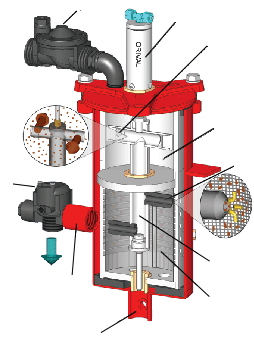
Dirty water enters the inlet 1 into the center of the fine screen 2. The water then passes through the fine screen from the inside out and exits to the outlet 3.
The unwanted solids accumulate on the inner surface of the fine screen, building up a filter cake which filters out even finer particles, creating a pressure differential. Once the pressure drop reaches a preset level, a rinse cycle is activated by the control system, opening the rinse valve 4 to an atmospheric drain and closing the optional controlled outlet valve (C.O.V.) 5.
As a result, pressure drops in the hydraulic motor chamber 6 and the dirt collector assembly 7. The pressure drop creates a backflush stream, which sucks the dirt off the screen, similar to a vacuum cleaner. The backwash water is carried through the nozzles 8 and the direct collector tube before being ejected out of the holes in the hydraulic motor 9.
The water being ejected out of the hydraulic motor causes the direct collector to rotate, similar to a sprinkler. In addition, the pressure drop in the hydraulic motor chamber forces the dirt collector assembly to move axially, controlled by hydraulic piston 10. This combination of movements ensures that the entire screen area is cleaned each cycle.